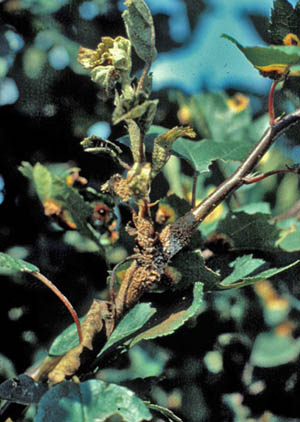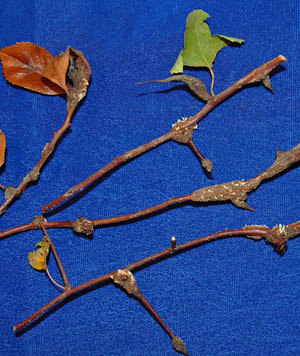Hawthorn Rusts | |
|---|---|
| May 6, 2008 | |
|
Technically hawthorns are susceptible to more than eleven rust species. When you look at rust problems on hawthorns in Illinois, there are only two to consider: cedar–hawthorn rust (Gymnosporangium globosum) and cedar–quince rust (G. clavipes). Ironically, cedar–hawthorn rust is not the significant threat to hawthorns. It causes leaf spotting that may be severe on some cultivars, but is does not disfigure the tree. The rust that may limit hawthorn growth is cedar–quince rust. Cedar–quince rust lives in the winter on Juniperus communis, J. horizontalis, J. sabina, and the usual J. virginiana (eastern red cedar). The summertime hosts include hawthorn, serviceberry, flowering quince, cotoneaster, and crabapple. The problem is that this rust infects the twigs and leaf petioles of hawthorn. Infected leaves shrivel up and die. The infected stems swell, resulting in stunted growth or dead stem tips. The images show (1) infection of hawthorn stems in the summer and (2) old stem infections.You might see old stem infections on your hawthorn now.   If you are considering planting new hawthorns this spring, keep this disease in mind. English hawthorn is reportedly resistant to the disease, while thornless cockspur and Washington hawthorns are quite susceptible. Chemical management of hawthorn rust is targeted at the hawthorn host. Fungicide applications begin at flowering and continue until 1 to 2 weeks past petal fall. Registered products include propiconazole, triadimefon, chlorothalonil, thiophanate-methyl, myclobutanil, and other products that are readily available to commercial applicators. Consult the Illinois Commercial Landscape and Turfgrass Pest Management Handbook for details. Homeowners have fewer choices but may use mancozeb or myclobutanil. Information on the rust diseases of apple, crabapple, and hawthorn can be found in Report on Plant Disease, no. 802, available at http://www.ag.uiuc.edu/~vista/abstracts/a802.html or in Illinois Extension offices. | |
| Author: | Nancy Pataky |
